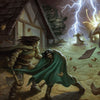By the way, if you’re a busy GM without enough to time to prep like you know you should, Lairs & Legends can help. Grab an adventure, read it in about 15 minutes, and you’re ready to run your game! With over 700 pages of 5e resources, there’s no reason to feel stressed out and overwhelmed before your next D&D game.
The Mourners’ March
Event Overview. The deep toll of a massive bell echoes throughout Appia, its sonorous knell reverberating deep into the stones. It tolls again just as the last echoes fade away. Smaller handbells ring out as a parade of mourners dressed in scarlet shuffle up the road, the solemnity of their passing leaving a weight upon the onlookers. Several toss red roses and other flowers onto the cobblestone road ahead of the procession, the fragrant flowers’ scents curling through the air as the mourners tread upon them. At last, the marchers reach the city’s peak, waiting in silence as the sun drifts to meet the horizon. When the last rays of light have faded, the mayor unfurls a scroll and recites a list of names to all in attendance.
The Mourners’ March began as a memorial during the Appia Revolution 86 years ago. During this time, the city was under the tyrannical control of a neighbor, Seralda, who ruled Appia with an iron fist. A group of patriots banded together to cast out the oppressive army, leading to a bloody battle that spilled onto Appia’s streets. At sunset, the clerics announced which comrades had fallen, ringing bells in their honor. Ultimately, the 69 patriots who lost their lives defending Appia’s freedom did not die in vain: the Seraldan Army withdrew from the city, and Appia’s independence was finally recognized. The revolutionary leader, Aella Kaveh, unfortunately, succumbed to her wounds the day after the Seraldan forces departed, making her the last casualty of the revolution.
Within five years of this momentous event, the Mourner’s March evolved to include memorializing important city figures who passed during that month on its final day. After 10 years, it expanded to include any citizens who died and deserved to be honored. The bell tolling every hour throughout the day, however, continued to symbolize the fallen 69 patriots and their leader.
People Involved. Few outsiders would know what to think of Appia’s Mourners’ March, let alone expect to participate in the event. For that matter, the stoic and disassociated approach to immediate grief may also be off-putting to foreigners. Instead, this event comforts local residents who need a way to express their grief.
Location. The Mourners’ March’s public events take place across all of Appia’s paved streets as the procession begins at the base of the hill and winds its way up to the top of the hill. Bystanders are encouraged to decorate the streets with red flowers and streamers to symbolize the blood shed to free Appia. Meanwhile, the city governor gathers with everyone who participated in the Mourners’ March for the sunset reading of the names in Kaveh Square, which features a large statue of Aella Kaveh to honor her achievements in the revolution.
However, many families who have suffered loss during that month will expand the monthly event into their own homes for private events. They spend the first hours of the day fasting and meditating on their loved ones. After the Mourners’ March concludes, these families usually return to their homes at dusk to host friends and family for an evening meal that often stretches deep into the early hours of the next morning.
Event Details
Roleplaying Notes.
· Wearing red on this day when not mourning a relative or friend is controversial, as it is the color of mourning in Appia’s tradition. The red symbolizes the blood of those who died during the revolution.
· A great solemnity fills the city on the final day of each month, broken rarely by laughter or joy. To speak frivolously or with the intent of interrupting the mourning through jest is considered a significant faux pas.
· Beginning at midnight until 11:00 that evening, the city hall’s bell tolls three times on each hour, its deep knells reverberating throughout the city.
· A respectful silence is expected by the city whenever the bells toll. The intention is to use those moments for reflection on those who have passed.
· Beginning at noon, a crowd of mourners who have lost loved ones in the past month gather at the base of Appia’s hill. After the third toll for the dead, they begin a long procession throughout the city, ringing handbells as they slowly wend their way through the city.
· Onlookers have been known to toss red roses into the streets as the procession passes their homes or businesses. This is the only socially approved way for those not mourning to honor the dead respectfully.
· The procession reaches the top of the settlement at sunset. Once everyone has gathered, the city’s governor reads the contents of a scroll listing the names of all who have passed during the month.
· At midnight the following day, the bell tolls one final time to honor the leader of the rebellion who succumbed to their wounds the day after Appia’s victorious stand against its oppressive neighbor.








